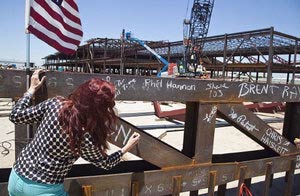Wichita Eagle; Steel skeleton nearly complete for new terminal at Wichita Mid-Continent Airport
06.10.13 · Greteman Group
June 10, 2013
Wichita Eagle
Elizabeth Scheltens

The terminal’s frame actually won’t be finished for another two weeks, but dozens of construction workers, project managers and local politicians gathered to watch a crane raise a symbolic steel beam, topped with an American flag and a miniature evergreen tree, and place it in the center of the building’s 267,000-square-foot steel skeleton. The ceremony and the evergreen tree are part of a tradition for construction workers that dates back to Viking days, said Mark Kelley, vice president and senior project manager at AECOM, the Los Angeles-based company managing construction of the terminal.
“When the Norse people would complete one of their longhouses, they’d have a big ceremony to celebrate putting in the last beam. That was the keystone that locked the building into place, made it the center of the community,” Kelley said.
Wichita Mayor Carl Brewer said it’s hard to think of a bigger project in Wichita in recent memory.
“Dreams really do come true,” Brewer said after he signed the steel beam with a piece of chalk. “This is the largest, most expensive project the city has taken on since Century II was built.”
The new terminal is being paid for by a $53 million grant from the Federal Aviation Administration. Airport passenger fees are covering the rest of the project’s $160 million price tag. Brewer said he’s confident the project will not need any local taxpayer money to continue, though the FAA is a taxpayer-funded federal agency. Kelley said the terminal would easily be complete by spring 2015 “unless something happens outside of our control.”
Pat McCollom of the Wichita Airport Authority said the terminal is about 25 percent complete. He said the building will be entirely enclosed by New Year’s.
UV-protected glass will make up about 60 percent of the terminal’s surface, McCollom said. The terminal was designed according to LEED standards, environmental building guidelines put forth by the U.S. Green Building Council. Along with the UV glass, the terminal will use skylights and groundwater-powered floor heaters for the sidewalk and foyers.
The current terminal contains asbestos and outdated heating and air-conditioning systems. It’s also missing a place for security officers to inspect baggage behind the scenes, which the U.S. Department of Homeland Security requires.
“Really, it’s just not up to code,” McCollom said.
To revamp the old terminal would have cost nearly as much as building a new one and would have caused headaches for travelers, said Victor White, also of the Wichita Airport Authority.
“Imagine the inconvenience of remodeling a kitchen, then multiply it exponentially,” White said.
The terminal has been in the works for nearly a decade. In 2004, the Wichita Airport Authority voted to move the project forward, but the City Council delayed the bidding process for years. When the city finally solicited bids in 2011 and chose Wichita-based Dondlinger Construction, it had to resolicit bids after Dondlinger was found not to have made a good-faith effort to bring enough disadvantaged-business subcontractors into the project. The FAA threatened to pull its funding for the new terminal because of the oversight, so the city dropped Dondlinger and gave the contract to the next-lowest bidder, Key Construction, another Wichita-based company. Key Construction broke ground on the new terminal in September 2012.
In 2010, when independent consultants recommended to the City Council that the project go forward, it did so based on projections of growing passenger traffic at the airport. But since 2003, the number of daily flights from Mid-Continent has decreased from 53 to 33. Passenger traffic has increased slightly, from 1.41 million in 2003 to 1.5 million in 2012, but that growth is still less than what was projected when the terminal was approved.